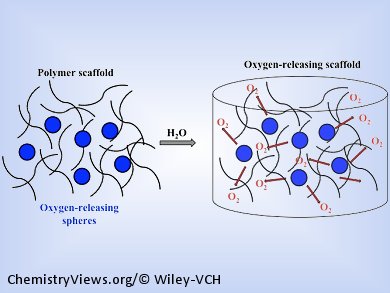Ali Khademhosseini and colleagues, Massachusetts Institute of Technology (MIT), Boston, USA, look at ways to integrate oxygen releasing agents into the material used for tissue engineering applications. The authors examine the oxygen releasing reagents, how these might be built into tissue matrices, and their potential applications for regenerative medicine.
Oxygen releasing materials can reduce hypoxic conditions caused by mass transport limitations in un-vascularized tissue-like constructs. This can be of particular use in maturation of newly formed tissue. Oxygen can be generated when solid inorganic peroxides, such as calcium peroxide, come into contact with water and react to form hydrogen peroxide, which in turn decomposes to form oxygen and water. Oxygen releasing reagents can be incorporated into the tissue matrix by either building them into the polymeric structure itself or by encapsulating them in core-shell or hydrogel type species.
The biggest challenge will be in designing systems that maintain slow release kinetics in a complex biological environment.
- Oxygen releasing biomaterials for tissue engineering,
G. Camci-Unal, N. Alemdar, N. Annabi, A. Khademhosseini,
Polym. Int. 2013.
DOI: 10.1002/pi.4502
Also of interest:
The author of the article, Professor Ali Khademhosseini, was the winner of the Third Polymer International-IUPAC Award for Creativity in Applied Polymer Science or Polymer Technology. Nominations are now open for the next prize.




